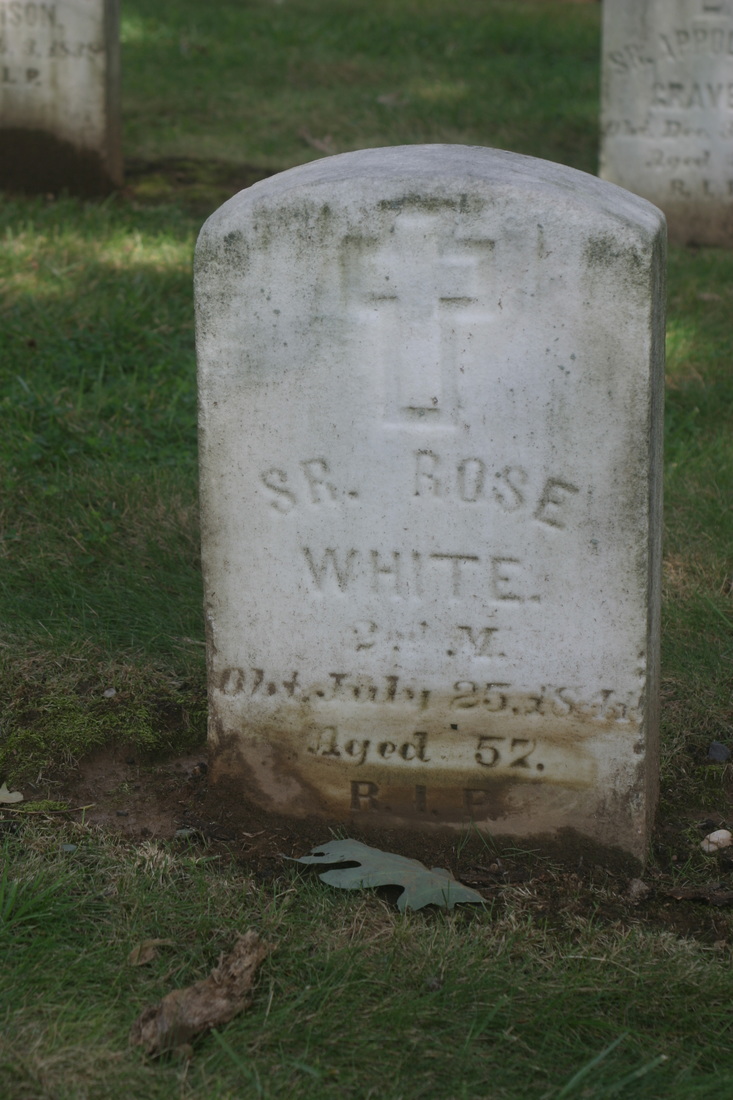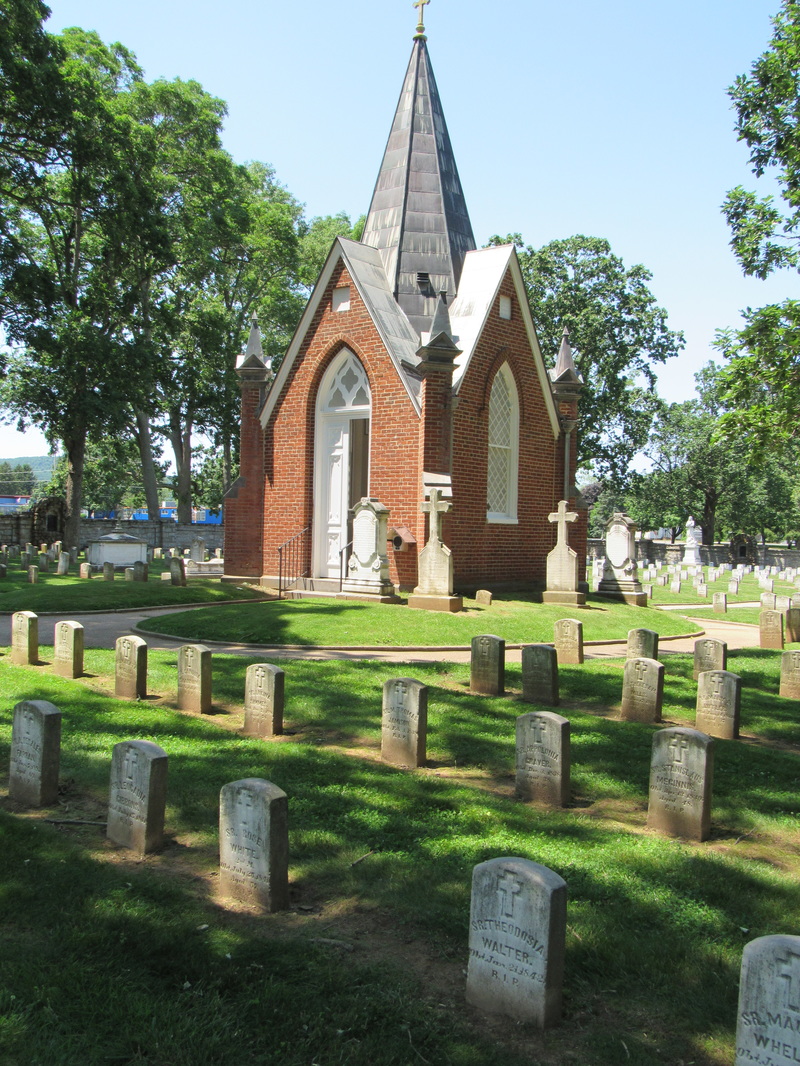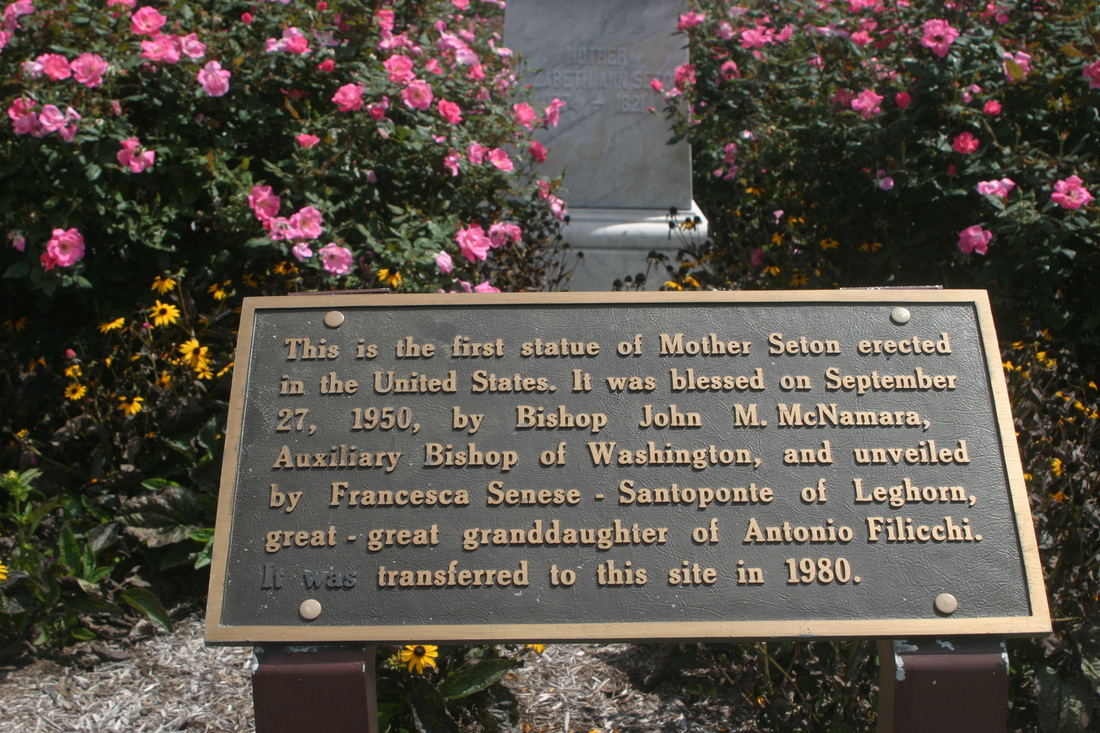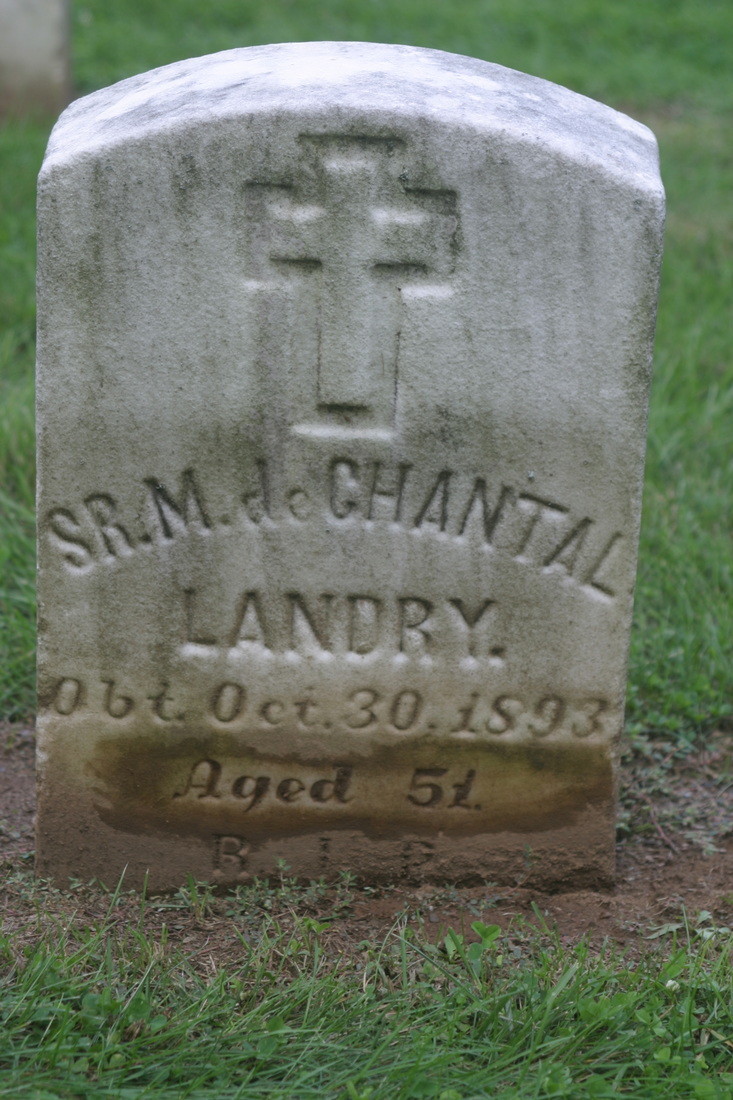Sister Rose Landry White arrived at Emmitsburg, Maryland in July of 1809 to serve the newly-formed Sisters of Charity of Saint Joseph, the first religious community of women founded in the United States.
Acadians in Emmitsburg
While at first Emmitsburg may seem to be an unlikely venue for tracing Acadians in Maryland, the remote Maryland town plays a significant role in Maryland’s Catholic educational history. Here Elizabeth Ann Seton and Rose Landry White, an Acadian, began their ministry in 1809 as the fledgling Sisters of Charity. Here also, the French Sulpicians created a seminary and college – the roots of which go back one year earlier to 1808. The commemorative marker in the cemetery (below left) celebrates unmarked burials there, including the unknown resting place of Sister Rose's own mother, Magdalen Jeaudain Landry (d. 1828), who spent her final two years under the care of the sisters at Emmitsburg.
Approximately 57 miles from Baltimore, straddling the border with Pennsylvania near Gettysburg and its Civil War battlefields, the town of Emmitsburg, Maryland is just a 24-mile car ride north from Frederick on Route 15.
The Catholic planter John Digges first noticed the area around Emmitsburg in the 1730s. By 1785 Samuel Emmit began selling lots to develop a town and exploit the land agriculturally. The academic endeavors at Emmitsburg preceded the town’s incorporation in 1825.
Father Dubois escaped France in 1791 with the help of his schoolmate Robespierre, spent some time in the Richmond, VA, area in his early days in America, came to western Maryland to be a missionary in 1794, led the nascent Mount St. Mary's (founded in 1808), and was the Sulpician Superior of the Sisters of Charity from 1811 until his appointment as Bishop of New York in 1826.
Mother Seton arrived at Emmitsburg in June 1809 and Sister Rose, her young and enthusiastic protégée, followed Elizabeth Seton to Emmitsburg with four sisters, two Seton children, two boarders, and a housekeeper. Rose sent for her own young son Charles later on. Both she and Mother Seton were widows with parental responsibilities as well. The younger of the two, Sister Rose, was married at the age of fourteen; however, her husband, Capt. Joseph White, Jr. of LeBlanc Acadian heritage, was lost at sea in 1804 before she had reached her twentieth year. One of the three daughters of George Landry and Magdelaine Jeaudain Landry, Sister Rose became Mother of the order in 1821 upon the death of the group’s foundress, Mother Seton. She served three additional three-year terms before her death in 1841. Sister Rose’s ministry took her to Emmitsburg, Philadelphia, New York City, Washington, DC, Baltimore, Brooklyn, and Frederick.
Mother Seton arrived at Emmitsburg in June 1809 and Sister Rose, her young and enthusiastic protégée, followed Elizabeth Seton to Emmitsburg with four sisters, two Seton children, two boarders, and a housekeeper. Rose sent for her own young son Charles later on. Both she and Mother Seton were widows with parental responsibilities as well. The younger of the two, Sister Rose, was married at the age of fourteen; however, her husband, Capt. Joseph White, Jr. of LeBlanc Acadian heritage, was lost at sea in 1804 before she had reached her twentieth year. One of the three daughters of George Landry and Magdelaine Jeaudain Landry, Sister Rose became Mother of the order in 1821 upon the death of the group’s foundress, Mother Seton. She served three additional three-year terms before her death in 1841. Sister Rose’s ministry took her to Emmitsburg, Philadelphia, New York City, Washington, DC, Baltimore, Brooklyn, and Frederick.
Acadian Sisters of Charity return to Maryland -- from Louisiana!
Interestingly, there are three other Landry graves in the Sisters of Charity cemetery at Emmitsburg. Sister de Chantal Landry (née Luce Marie Magdelaine Landry, 1842-1893) and Sister Maria Landry (née Marie Aimée Landry, 1836-1877) were siblings from Donaldsonville in Ascension Parish, Louisiana. Both taught at St. Joseph's Academy in Emmitsburg. They entered the Sisters of Charity order about ten years apart and spent their entire ministry in Emmitsburg. Sisters De Chantal and Maria were grandchildren of Joseph Landry and Anne Bigeo (Bijeau), who were listed in 1763 as eleven and six years old, respectively. They were living at this time with their exiled families in Oxford. In the 1760s these Acadian families left Maryland along with other Acadians to resettle and begin a new life in Louisiana. Amazingly, Sisters De Chantal and Maria both returned to Maryland a century after the exile to do their life’s work with the Sisters of Charity at Emmitsburg!
The third Landry nun buried in the cemetery, Sister Louise Landry (née Julia Martha Landry, 1886-1965), was born in Algiers across the Mississippi River from New Orleans. She died in Baltimore after serving with the Daughters of Charity, as the Order became known. Sister Louise also had early Maryland Acadian roots.
Two other notable persons of Acadian descent, Mary Guthrow Chamberlain Grover and Dr. Anthony Hermange, moved to Emmitsburg from Baltimore in the early 19th century. Mrs. Grover was a childhood friend of Sister Rose and had also lost her husband at sea. Dr. Hermange, whose mother was an Acadian Boudreau, taught physics and chemistry at Mount St. Mary’s College in Emmitsburg.
Note: To magnify the above image(s), using Chrome, right mouse click on the document and select "Open image in new tab." Or in Firefox, right mouse click on the document and select "View Image." Then use your magnifying glass to enlarge the print. In IE, use the standard "zoom" feature to enlarge your page. In Safari, right mouse click on the document and select "Open Image in New Window." Also, by clicking CTRL and then the + / - keys you may enlarge or reduce the size of any page on the site.













